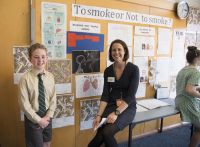
When children nag their parents to read the nutrition labels of cereal boxes to make a healthier shopping choice, you know they are being educated about health correctly.
This was just one of the stories emerging from the recent pilot at Blackmans Bay Primary School of the HealthLit4Kids program, led by University of Tasmania researchers Dr Rosie Nash and Dr Shandell Elmer.
The program, which has now been launched at Bowen Road Primary School (Moonah), St Brigid’s Catholic School (New Norfolk), East Launceston Primary (East Launceston) and Montello Primary (Burnie), aims to improve the health literacy (and ultimately the health) of children and their families and is already making great inroads into changing the way students think about their mental and physical health.
“Health literacy is complicated in that it is embedded in our social context and the community in which we live, so one of the best places to address health literacy is in schools,” Dr Nash said.
“Previous research shows that health literacy has strong links to our health, social equity and educational attainment.”
“If we can support children to develop health literacy and empower them from an early age it can make a big difference to their trajectory for their whole life course.”
While health literacy (the ability to access, read, understand and use healthcare information to make appropriate health decisions) is something that can be supported in the home, Dr Nash said in order to improve the health and wellbeing of our communities, health literacy should also be developed in the classroom alongside numeracy and literacy.
“To ensure equity of access, we’ve worked with teachers, parents and children to design a HealthLit4Kids Action Plan for each school and to date we have had great feedback and engagement.”
HealthLit4Kids involves professional development workshops for teaching staff and development of health literacy activities for students, across all aspects of the curriculum – not just in health classes.
“International literature highlights that classroom teachers often lack the confidence to teach health topics,” Dr Nash said.
“Our program provides teachers with the confidence to start conversations about health and explore health literacy with their students and their families.”
The student’s classroom learning activities culminate in the making of ‘artefacts’ to showcase what they have learned, whether they be film, written stories, art or craft, which are then shared at an expo or another school community event.
Dr Nash said the program will also assist the research team with the insight required to develop a method for determining the appropriate ‘levels’ of health literacy of young children.
“Internationally, there is currently no tool for assessing the health literacy of children under 10 years of age,” she said.
While the project is something the team has been working hard towards since 2016, it is thrilled at the way the program has been embraced and what this could mean for the future of children’s health and the health of Tasmanian communities.
HealthLit4Kids is supported with funding from The University of Tasmania and the Tasmanian Community Fund.
Published on: 13 Sep 2018 8:03am